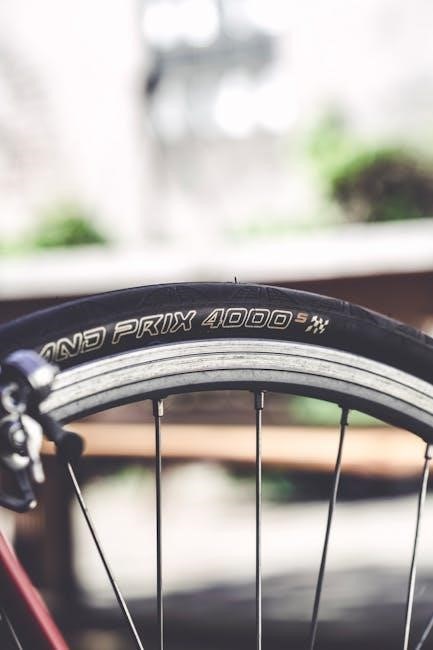Choosing the right bicycle frame size is crucial for comfort, performance, and control. This guide helps you understand how to measure and select the perfect frame size for your needs, ensuring a enjoyable riding experience.
1.1 Why Frame Size Matters
Frame size is crucial for comfort, efficiency, and safety. A well-fitting frame ensures proper posture, reducing strain and discomfort during rides. It also optimizes pedaling efficiency and handling, making the bike easier to control. Incorrect sizing can lead to fatigue, discomfort, or even injury. Measuring height and inseam helps determine the ideal size, varying by bike type and brand. Professional fitting is recommended for optimal performance and safety. A correctly sized frame enhances the overall cycling experience, providing better control and reducing the risk of accidents. Always consider body proportions, riding style, and bike type when selecting a frame size for the best fit.

1;2 Brief Overview of Bike Sizing
Bike sizing involves matching your body measurements to the right frame size for optimal comfort and performance. Key measurements include height and inseam, which help determine the ideal frame size. Bike sizing charts vary by brand and bike type, such as road, mountain, or hybrid bikes. These charts provide a starting point, but personal fit and riding style also play a role. Proper sizing ensures efficient pedaling, better control, and reduced discomfort. While charts are helpful, professional bike fittings and test rides are recommended for the best fit. Understanding bike sizing basics helps cyclists make informed decisions when selecting a new bike, ensuring a safe and enjoyable riding experience.
How to Measure for Bicycle Frame Size
Measuring for a bicycle frame size involves determining your height and inseam. These measurements are critical to ensure a proper fit and comfortable riding experience.
2.1 Measuring Your Height
To measure your height accurately for a bicycle frame size, stand against a wall with your feet flat on the floor and shoulders relaxed; Ensure you’re wearing your regular cycling shoes. Place a pencil horizontally on top of your head and mark the wall. Measure this distance using a tape measure. This height measurement is essential for determining the appropriate frame size. Consistency across brands is key, so double-check your measurement to avoid errors. Accurate height measurement ensures a proper fit, enhancing comfort and control while riding. This step is foundational for selecting the right bike frame size.
2.2 Measuring Your Inseam (Inside Leg Length)

To measure your inseam, stand against a wall with your feet flat on the floor, wearing your cycling shoes. Place a pencil or ruler vertically between your legs, touching the inner thigh, and mark the wall at the top of the ruler. This distance is your inseam. For accuracy, repeat the process a few times and take the average measurement. Your inseam is crucial for determining the correct frame size, as it directly affects the standover height and overall fit. A proper inseam measurement ensures the bike is neither too large nor too small, providing optimal comfort and control while riding. This step is vital for a precise fit.
Understanding Bicycle Frame Size Types
Frame sizes vary across bike types, with road, mountain, hybrid, and gravel bikes offering distinct fits. Each type is tailored to specific riding styles and terrains.
3.1 Road Bike Frame Sizes
Road bike frames are designed for speed and efficiency, typically featuring sleek, aerodynamic designs. Frame sizes are usually measured in centimeters, ranging from 47cm to 63cm. These bikes emphasize a more aggressive riding position, with a focus on handlebar drop and reach. The frame geometry is optimized for responsiveness, making them ideal for racing and long-distance rides. Materials like carbon fiber, aluminum, or steel are commonly used, each offering distinct performance characteristics. Sizing charts often correlate rider height and inseam to frame size, but fit can vary between brands. Proper sizing ensures optimal power transfer and comfort during extended periods in the saddle.
3.2 Mountain Bike Frame Sizes
Mountain bike frames are designed for durability and stability on off-road terrain. Sizes typically range from small to extra-large, with specific measurements varying by brand. Standover height is a key factor, ensuring there’s enough clearance for the rider. Mountain bikes often feature shorter wheelbases for better maneuverability and slacker head angles for improved control on rough trails. Frame materials include aluminum, steel, and carbon fiber, each offering different strength-to-weight ratios. Suspension systems also influence frame size, with hardtail and full-suspension bikes having distinct geometries. Sizing charts usually correlate rider height to frame size, but personal preference and riding style can affect the best fit. Proper sizing ensures comfort and control on technical terrain.
3.3 Hybrid Bike Frame Sizes
Hybrid bikes combine elements of road and mountain bikes, offering versatility for commuting and casual rides. Frame sizes are typically categorized as small, medium, large, and extra-large, with measurements varying slightly by brand. Standover height and seat tube length are key factors, ensuring a comfortable riding position. Hybrid frames are often made from aluminum or steel, balancing durability and weight. Sizing charts usually match rider height to frame size, but inseam and riding style also play a role. For example, a medium frame might suit riders between 5’6″ and 5’9″. Proper fit ensures efficiency and comfort, whether on paved paths or light trails. Testing a bike before purchase is recommended for optimal sizing.
3.4 Gravel Bike Frame Sizes
Gravel bike frame sizes are designed to accommodate a mix of on-road and off-road riding, offering a versatile fit. Frames are typically sized similarly to road bikes but with slight adjustments for a more relaxed geometry. Sizes range from small to extra-large, with standover height and reach being critical measurements. Rider height and inseam are key factors, with most brands providing charts to match these to frame sizes. For example, a medium frame might suit riders between 5’8″ and 5’11”. The upright riding position of gravel bikes emphasizes comfort, making proper fit essential. Materials like aluminum, carbon fiber, or steel are common, balancing weight and durability. Testing a bike in person is recommended to ensure the best fit, as personal comfort and handling preferences vary.

Factors Influencing Frame Size
Body proportions, riding style, and gender differences significantly influence frame size selection, ensuring optimal comfort, efficiency, and control for riders of all sizes and preferences.
4.1 Body Proportions and Fit
Body proportions play a crucial role in determining the ideal frame size. Torso length, arm reach, and leg proportions vary among individuals, even for those of the same height. A longer torso may require a larger frame to maintain comfort, while shorter arms might need a different handlebar setup. Leg length, measured by inseam, directly impacts standover height and pedaling efficiency. Riders with longer legs may prefer a slightly smaller frame for better control. Additionally, body type, such as broader shoulders or narrower hips, can influence the fit. Proper alignment of the body on the bike ensures optimal performance, comfort, and reduces the risk of injury. Accurate measurements and professional fitting are essential for a tailored fit.

4.2 Riding Style and Purpose
Riding style and purpose significantly influence frame size selection. Different bike types, such as road, mountain, or hybrid, are designed for specific riding styles. Road bikes require an aerodynamic position, often leading to a more compact frame size. Mountain bikes prioritize stability and control, sometimes necessitating a slightly larger frame for durability. Hybrid bikes offer versatility, balancing comfort and efficiency. The intended use of the bike, whether for racing, commuting, or off-road adventures, impacts frame geometry. Riders should consider their riding position preferences—aggressive for speed or upright for comfort. Aligning frame size with riding style ensures optimal performance and comfort. Always test ride bikes to match your specific needs and preferences for the best fit.
4.3 Gender Differences in Frame Design
Gender differences in frame design cater to average body proportion variations. Women’s frames often feature shorter top tubes and longer seat stays for better reach and stability. Handlebars may be narrower to suit smaller shoulder widths. Seat height and saddle design also vary, with women’s saddles typically wider for comfort. Men’s frames may prioritize stiffness and power transfer. However, these differences are general trends, and individual preferences can override gender-specific designs. Modern unisex frames blur these lines, focusing on rider-specific needs. Always consider personal comfort and fit when choosing a frame, regardless of gender-based designs. Professional fitting can help ensure the best match for your body and riding style.

How to Use a Bicycle Frame Size Chart
Align your height and inseam with the chart to find your ideal frame size. Match measurements to corresponding sizes, ensuring proper fit and comfort for efficient riding.
5.1 Reading a Bike Size Chart
A bike size chart typically displays height and inseam measurements alongside corresponding frame sizes. The chart is divided into rows and columns, with height ranges on one axis and frame sizes on the other. To read it, locate your height and inseam in the chart and follow the row to find the recommended frame size. Sizes are often categorized as Small, Medium, Large, etc., or in inches/centimeters. Pay attention to any notes about standover clearance or wheel size, as these can affect fit. Some charts may also differentiate between male and female frames, reflecting gender-specific design variations. Always cross-reference your measurements for accuracy.
5.2 Height vs. Inseam: Finding Your Match

Height and inseam are key measurements for determining frame size, but they serve different purposes. Height provides a general estimate, while inseam offers precision for standover clearance and leg extension. Start by identifying your height range in the chart, then refine it with your inseam measurement. If your inseam is longer or shorter than average for your height, adjust the frame size accordingly. For example, a taller inseam may require a larger frame, while a shorter inseam might suit a smaller size. Always cross-reference both measurements to ensure optimal fit. Manufactures may vary slightly, so double-check their specific sizing guidelines. This dual approach ensures a bike that matches your body proportions and riding comfort.
5.3 Converting Sizes Across Brands
Different bicycle brands often have varying frame size standards, making direct comparisons challenging. To convert sizes across brands, start by referencing each manufacturer’s specific size chart. These charts typically correlate height and inseam measurements to frame sizes. Some brands provide detailed conversion guides or sizing tools on their websites to help match their sizes with competitors. Additionally, compare standover heights and seat tube lengths, as these can differ slightly between brands. If unsure, visit a local bike shop for professional guidance or use online size-matching resources. Testing multiple brands and sizes is recommended to ensure the best fit, as small variations in design can significantly impact comfort and performance.

How to Choose the Right Frame Size
Choosing the right frame size involves considering personal comfort, riding style, and bike type. Consult size charts, test ride bikes, and seek professional fitting for optimal fit and performance.
6.1 Tips for Trying Before Buying
Test riding a bike is crucial to ensure the frame size and fit are right for you. Visit a local bike shop to try different models and sizes. Check the standover clearance by standing over the bike with your feet flat; there should be 1-2 inches for road bikes and 2-4 inches for mountain bikes. Adjust the saddle height to match your leg length, ensuring a slight bend in the knee when the pedal is at its lowest point. Pay attention to handlebar reach and overall comfort. Spend at least 10-15 minutes riding to gauge how the bike feels. This hands-on approach helps confirm the right size and ensures a comfortable, efficient ride.
6.2 The Role of Professional Bike Fitting
A professional bike fitting ensures your frame size and overall setup are optimized for comfort and performance. Experts use specialized tools like sizing bikes or dynamic fitting systems to assess your body proportions, riding style, and flexibility. They adjust components such as saddle height, handlebar reach, and pedal alignment to create a personalized fit. This process minimizes the risk of discomfort, injury, or inefficiency. While frame size is a starting point, a professional fitting fine-tunes every aspect of the bike to match your unique needs. Investing in a professional fit can enhance your riding experience, especially for long-distance or competitive cycling. It’s a valuable step for serious riders seeking peak performance and comfort.

Common Mistakes to Avoid

Common mistakes when selecting a bicycle frame size can lead to discomfort and poor performance. Avoid these pitfalls to ensure a proper fit and enjoyable riding experience.
7.1 Guessing Your Frame Size
Guessing your frame size is a common mistake that can lead to an ill-fitting bike, causing discomfort and affecting performance. Many riders assume their size based on general height or inseam without proper measurement. This oversight can result in a bike that’s too small or too large, leading to issues like poor posture, strain on the neck and back, and reduced control. Always take precise measurements and consult a size chart or professional fitter to ensure accuracy. Accurate sizing is crucial for optimal comfort, efficiency, and safety while riding. Never rely on estimates when your riding experience is at stake.
7.2 Ignoring Body Proportions
Ignoring body proportions is a significant oversight when selecting a bicycle frame size. While height and inseam are crucial, other factors like arm length, torso length, and leg proportions also play a role. Riders with longer torsos or shorter arms may need adjustments to handlebar height or stem length. Similarly, variations in leg-to-torso ratios can affect riding comfort and efficiency. A one-size-fits-all approach often leads to discomfort and poor performance. Proper bike fitting considers these individual differences to ensure optimal positioning and reduce the risk of fatigue or injury. Always account for your unique body proportions to find a frame that complements your physiology and riding style.
7.3 Not Considering Riding Position
Not considering riding position is another common mistake when choosing a bicycle frame size. Different bikes are designed for specific riding positions, such as the aggressive posture of road bikes or the upright comfort of hybrid bikes. Ignoring how you’ll be positioned on the bike can lead to discomfort, poor performance, and even injury. For example, a road bike frame may feel too stretched for someone who prefers a more upright position, while a mountain bike may feel too cramped for long-distance riding. Always consider your riding style and the type of bike you’ll be using to ensure the frame size aligns with your intended riding position. Test rides can help confirm the best fit for your needs.
Selecting the right bicycle frame size is crucial for comfort, performance, and safety. By following this guide, you can make an informed decision tailored to your needs. Always test ride bikes to ensure the best fit and enjoy a more enjoyable cycling experience.
8.1 Final Thoughts on Frame Size Selection
Selecting the right bicycle frame size is a critical decision that impacts your cycling experience. Proper fit ensures optimal performance, comfort, and efficiency. While height and inseam are key starting points, body proportions, riding style, and personal preference also play significant roles. Different bike types, such as road, mountain, or gravel bikes, may require adjustments in sizing due to varying geometries. It’s essential to use a size chart as a guide but not rely solely on it, as minor variations exist between brands. Testing bikes in person and seeking professional bike fitting can provide further assurance. Taking the time to get the right fit will enhance your overall cycling enjoyment and reduce the risk of discomfort or injury.
8.2 Encouragement to Test Ride Bikes
Test riding a bike is an essential step in ensuring the perfect fit and performance for your cycling needs. While size charts and measurements provide a foundation, they can’t fully capture the feel of a bike. By test riding, you can assess comfort, handling, and how well the bike matches your riding style. It’s an opportunity to validate your research and confirm that the frame size and type are right for you. Many bike shops offer test rides, allowing you to compare models and make an informed decision. Don’t hesitate to take advantage of this step—it can make a significant difference in your overall cycling experience and satisfaction with your purchase.
